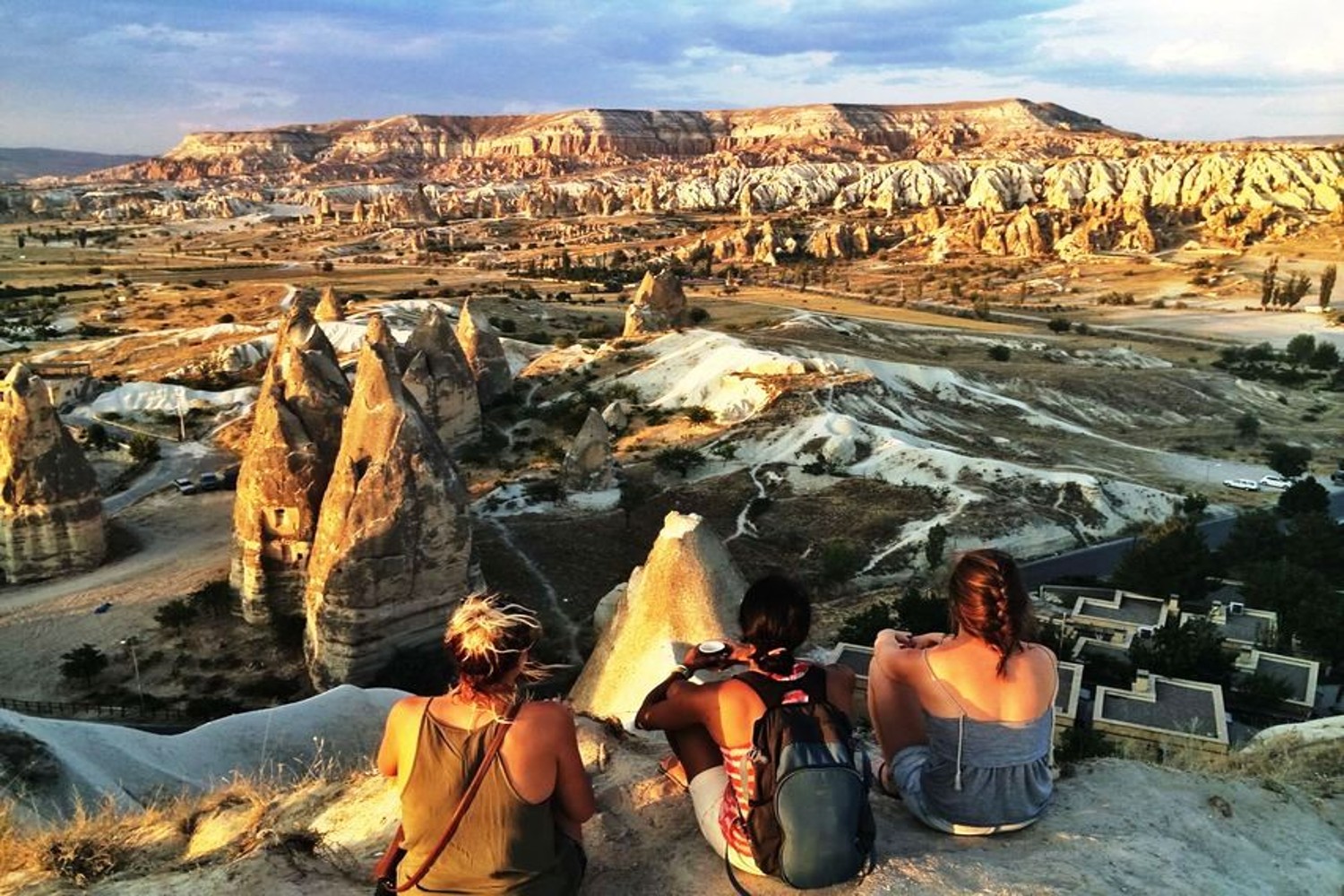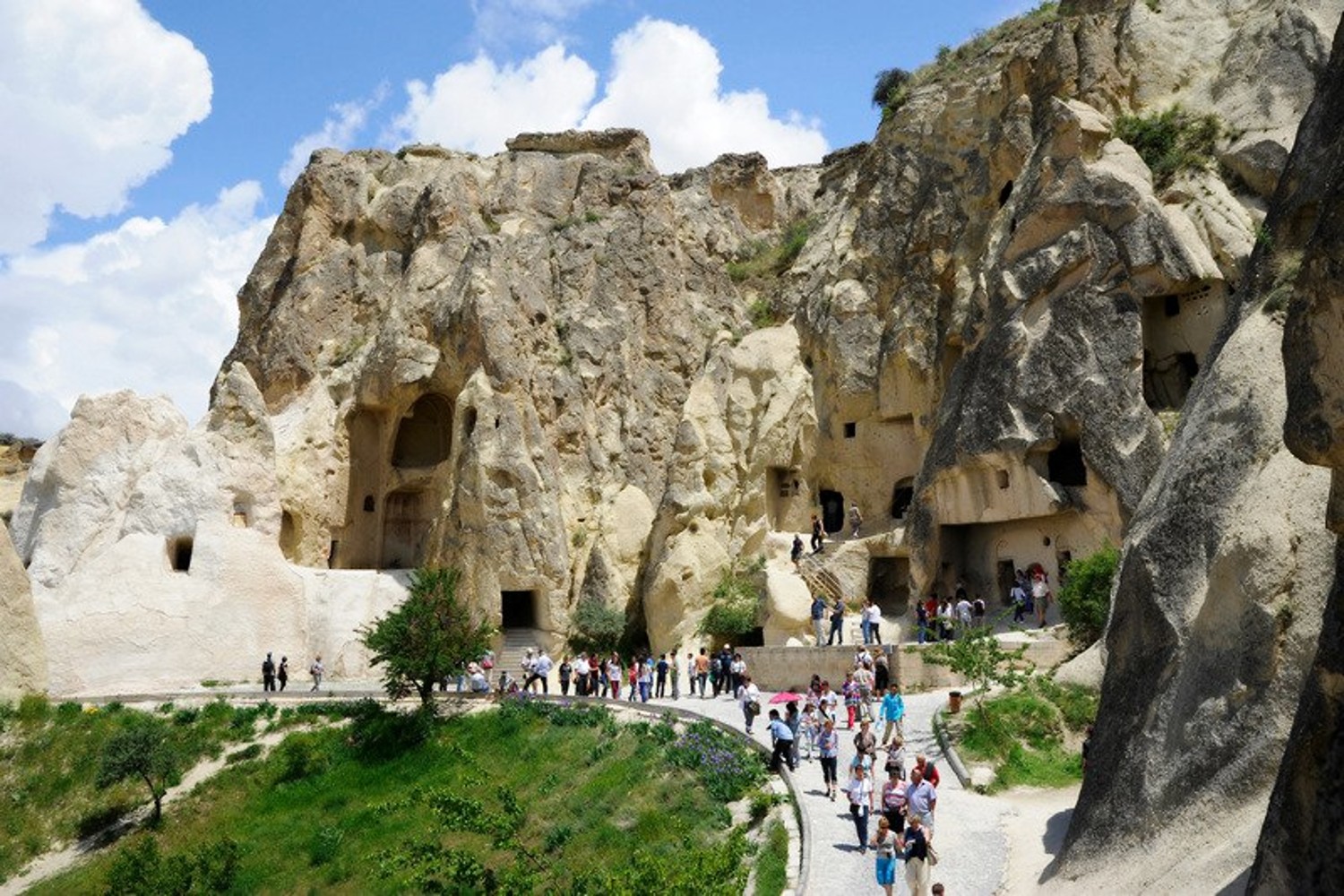CappadociaCappadocia Activitiescappadocia goremeGoremeGöremegoreme open air museumgöreme open air museumgoreme townwhere to go in cappadocia
Cappadocia - Göreme Town History - Open Air Museum - Tours and Shuttle

One o f Turkey’s World Heritage sites, the Göreme Open-Air Museum is an essential stop on any Cappadocian itinerary
History Of Göreme Town
The Christians, taking shelter in the valleys of Göreme because of Arab raids, named this place "gör emi” meaning ‘you cannot see this place. By time it changed to Korama and then to Göreme. With its very interesting fairy chimneys and the rock-cut churches, the valley of Avcılar, 17 km from Nevşehir and 6 km from Ürgüp, attracts travellers’ attention. St Paul considered Göreme to be more suitable for the training of missionaries. There are about 400 churches in the vicinity of Göreme which was one of the important centres of Christianity between the 6th and the 9th C.. Goreme area may once have been bigger including Mustafapaşa, Avcılar, Uçhisar, Ortahisar and Çavuşin. But today it’s limited to this small valley.
The rock churches near Göreme are:
Tokalı (Buckle) Church, Çarıklı (Sandals) Church, Karanlık (Dark) Church. Church of Mother Mary, Elmalı (Apple) Church, Yılanlı (Snake) Church, Church of St Barbara and El Nazar Church.

Top Selling Goreme Tours
Inside the Goreme Open air Museum
(Göreme Open Air Museum: 8.30am-7pm Apr-Oct, 8am-5pm Nov-Mar)

A cluster of rock-cut Byzantine churches, chapels and monasteries 1km uphill from the centre of the village, it deserves at least a two-hour visit. Try to arrive early in the morning in summer and space yourself between tour groups – apart from the crowds, when lots of people crowd into one of these little churches they block the doorway, which is often the only source of light. And if at all possible, avoid visiting on weekends, when the site is packed with domestic tourists.
To the left, after you enter, is the Rahibeler Manastırı (Nun’s Convent). Although this was originally several storeys high, today you can only see what is thought to be the large plain dining hall, with steps up to a small chapel (with unremarkable frescoes). To its right is the similar Monk’s Monastery. Follow the cobbled path until you reach Aziz Basil Şapeli (Chapel of St Basil). It’s rather dark inside because the main room is off to the left, away from the door. The grate-covered holes in the floor were graves.

Some say the Angel Gabriel, above the central nave, is holding it. There’s also some decoration typical of the iconoclastic period (725–842) when images were outlawed – red ochre painted on the stone without any images of people or animals.
The Azize Barbara Şapeli (Chapel of St Barbara) has iconoclastic decoration, beautiful in its simplicity. There’s also a fairly worn fresco of Christ the Pantocrator in the apse, and frescoes of the Virgin Mary and St Barbara
The Yılanlı Kilise (Snake Church or Church of St Onuphrius) has 11th-century frescoes on part of the vault. On the left wall, St George and St Theodore attack the dragon, while Constantine the Great and his mother Helena hold the True Cross. On the right wall, the naked St Onuphrius, a hermit from Egypt, hides his nudity behind a date palm frond.
A few steps from the Yılanlı Kilise, don’t miss the refectory, with its long dining table and benches cut from the rock. At the end of the table is a trough in the floor that was probably used for pressing grapes.
Attached to the refectory is a larder, where you can see storage shelves carved into the walls, and a kitchen.
Another smaller, nameless church here retains a rock-cut iconostasis. The stunning fresco-filled Karanlık Kilise (Dark Church; extra admission) is the most famous of the Open-Air Museum’s churches. It took its name from the fact that it originally had very few windows. Luckily this lack of light preserved the vivid colour of the frescoes, which show, among other things, Christ as Pantocrator, Christ on the Cross and the Betrayal by Judas. The church was restored at great expense, which partly explains the extra fee to visit it. However, the charge is also intended to keep numbers down in an attempt to preserve the frescoes.
To the left, after you enter, is the Rahibeler Manastırı (Nun’s Convent). Although this was originally several storeys high, today you can only see what is thought to be the large plain dining hall, with steps up to a small chapel (with unremarkable frescoes). To its right is the similar Monk’s Monastery. Follow the cobbled path until you reach Aziz Basil Şapeli (Chapel of St Basil). It’s rather dark inside because the main room is off to the left, away from the door. The grate-covered holes in the floor were graves.
Back on the path, the first place you’ll come to is the Elmalı Kilise (Apple Church), with a stunning display of frescoes, eight small domes and one large dome.
Where’s the apple?

The Azize Barbara Şapeli (Chapel of St Barbara) has iconoclastic decoration, beautiful in its simplicity. There’s also a fairly worn fresco of Christ the Pantocrator in the apse, and frescoes of the Virgin Mary and St Barbara
The Yılanlı Kilise (Snake Church or Church of St Onuphrius) has 11th-century frescoes on part of the vault. On the left wall, St George and St Theodore attack the dragon, while Constantine the Great and his mother Helena hold the True Cross. On the right wall, the naked St Onuphrius, a hermit from Egypt, hides his nudity behind a date palm frond.
A few steps from the Yılanlı Kilise, don’t miss the refectory, with its long dining table and benches cut from the rock. At the end of the table is a trough in the floor that was probably used for pressing grapes.
Attached to the refectory is a larder, where you can see storage shelves carved into the walls, and a kitchen.
Another smaller, nameless church here retains a rock-cut iconostasis. The stunning fresco-filled Karanlık Kilise (Dark Church; extra admission) is the most famous of the Open-Air Museum’s churches. It took its name from the fact that it originally had very few windows. Luckily this lack of light preserved the vivid colour of the frescoes, which show, among other things, Christ as Pantocrator, Christ on the Cross and the Betrayal by Judas. The church was restored at great expense, which partly explains the extra fee to visit it. However, the charge is also intended to keep numbers down in an attempt to preserve the frescoes.
Just past the Karanlık Kilise, the Azize Katarina Şapeli (Chapel of St Catherine) has frescoes of St George, St Catherine and the Deesis.
The Çarıklı Kilise (Sandal Church) is named for the footprints marked in the floor opposite the doorway. One of the best frescoes (in the arch over the door to the left) shows the Betrayal by Judas.
When you exit the museum, don’t forget to cross the road and visit the Tokalı Kilise (Buckle Church), 50m back down the hill towards Göreme on the right. This is among the biggest and finest of the Göreme churches, with fabulous frescoes in the two main chambers, and two smaller chapels (one underground).
Entry is via the 10th-century ‘old’ Tokalı Kilise, through the barrel-vaulted chamber covered with frescoes portraying the life of Christ. The ‘new’ church, built less than a hundred years later, is also alive with frescoes on a similar theme.








0 comments